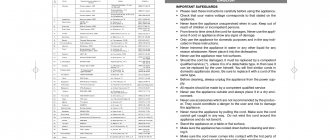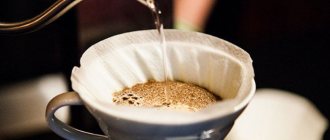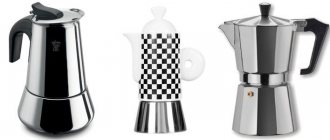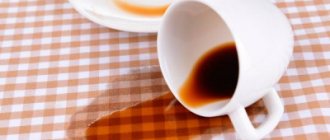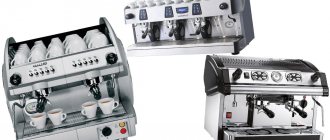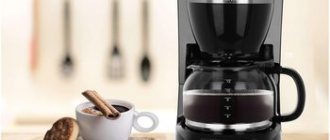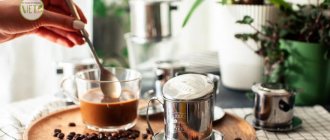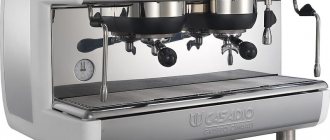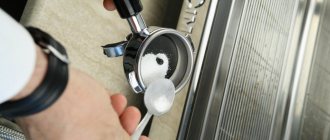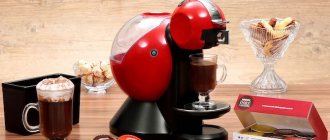Make water pass through paper
You know that paper is a web of plant fibers between which water can accumulate. However, particles of some chemical compounds are not able to get into these cells simply because they are too large. This elementary consideration is extremely important for us. This property allows solutions to be filtered.
To figure out how this happens, let's imagine that we accidentally mixed some salt and fine gravel. How can we separate the salt from the rocks? Agree, the easiest way would be to sift the mixture through a piece of window screen. Only small particles of salt will be able to pass through the small holes, and the pebbles will remain on the mesh. If you use a mesh with smaller holes, you can separate even smaller particles. And a sheet of paper can be used simply as... a grid with very, very small cells. For this reason, researchers often use a paper filter in many experiments. You can try the same.
Making a paper filter
Place the funnel in the glass. Fold the paper square in half and then in half again. Open it on one side to form a bag. Place it in the funnel. You will notice that if you now pour water into the funnel, it will be retained by the paper and will slowly begin to seep through it, dripping into the glass.
If you've ever seen a piece of filter paper in a chemistry lab, you know it's not like yours. Most paper filters are round. Try cutting a circle out of a sheet of paper towel (you can trace a saucer for convenience). The round piece of paper is folded in the same way: in half and in half again. You will find that a round filter is much more comfortable than a square one, but for later testing you can use filters of any shape.
Paper filter experiment
Sprinkle pepper into the water until the surface is almost completely covered. Stir the water so that the peppercorns are scattered throughout the volume. Then carefully pour the water into your filter, making sure all of it gets into the paper and doesn't spill over the edge.
When all the water has seeped through the paper into the glass, look into the filter. You will find that most of the pepper remains on the paper "mesh" only because it cannot fit through its small holes. You can remove the pepper paper and throw it away.
Have you removed all the pepper from the water? Most likely no! Confirm this by looking through the water at the light. It will probably have a brownish tint.
Why didn't your filtering remove all the pepper? Naturally, because some particles were small enough to slip through the cells in the paper. Can you suggest a way to make the filter even better?
To make a filter that works cleaner, use one of three different methods. You can try each of them and find out which one works best for you.
Method 1: Filtering
Filter the water and pepper mixture using a paper towel filter as before. Throw away the paper and make a new filter. Strain the solution, which has already been filtered once, through a new filter, then throw it away too. If you can still notice pepper in the water, repeat the process. How many times will you filter the solution before you finally catch all the peppercorns? (If you can get rid of them, of course.)
Method 2: multi-layer filtration.
Make a filter out of a paper towel and place it in the funnel. Then make another one and insert it into the first one. Strain the water and pepper through two filters at once. Do you doubt that the second filter will catch the peppercorns missed by the first? If the solution does not clear with a double filter, perhaps a funnel with three, four, etc. paper filters will.
Method 3: Fine Filtration
Now you understand that the biggest problem when using paper towels is that the holes in such paper are too large. Perhaps paper with smaller holes will do a better job. For example, newsprint has smaller holes between the fibers - try using it as a filter to separate peppercorns from water. Filter paper used in chemistry laboratories has very tiny holes. This is a special paper that is made specifically for filtering.
You will find that the smaller the holes, the longer it will take for water to seep through. In fact, you can more or less accurately determine how small the holes are by the time it takes for water to pass through them. You may find paper with even smaller holes than newsprint or paper towel.
Any of these methods can be used to isolate substances from mixtures. Often he combines several methods. For example, it uses several sheets of very thin paper (multi-layer fine filtration) and even repeats this process several times (re-filtration) until a satisfactory result is obtained.
Please also remember that in our tests we were trying to make the water we started with clean. A scientist often pursues the opposite goal. If we accidentally spilled our pepper in the water and wanted to get it back, all of these methods would come in handy again. If a scientist wants to isolate an insoluble compound from an aqueous solution, he will of course use a paper filter , retaining the substance retained by the paper and pouring out the water itself.
Filter materials used in laboratory practice can be divided into two classes: 1) bulk and 2) porous. In addition, filter materials are divided into 1) inorganic and 2) organic.
The first class includes, for example, quartz sand. It can have different grain sizes. Both the filtration speed and the effect achieved depend on this. The larger the sand grains, the greater the filter’s performance and, at the same time, the lower its retention capacity; the filter will only retain larger particles, while small ones will pass through it without being retained.
In many cases, porous materials are used (unglazed porcelain filter crucibles and porcelain plates, pressed glass, plates of pressed oxides of certain metals, ceramic filters, etc.).
Inorganic filter materials are especially suitable for liquid substances and solutions heated to temperatures exceeding 100* C.
How to increase strength?
Real filter paper, of course, is much stronger than an ordinary blotter, but it still sometimes breaks. Especially when you need to filter a large volume of liquid. The paper processing method proposed below increases its tensile strength by 10 times! At the same time, the filtering qualities do not deteriorate.
So, all you need to do is wet the paper with 70% nitric acid (density 1.42 g/cm3) and immediately rinse with plenty of distilled water.
After thorough washing, the paper should be dried and used as needed. Such paper does not introduce any contaminants into the filtered solution and is suitable for the preparation of medicines or use in analytical chemistry.
Paper treated in this way becomes so strong that a 5 cm wide strip of it can easily support the weight of a 1.5 kg weight. While ordinary filter paper breaks even at a weight of 150 grams.
Filter paper from different manufacturers has a pore diameter from 1.5 to 35 microns. At the same time, it is practically possible to purify liquids from impurities with a particle size of 1-2 nm (large pores in the paper become clogged, and filtration becomes finer).
The smaller the pore size of the paper and the greater the amount of sediment in the liquid being purified, the slower the filtration process. In some cases, you have to wait for hours for the process to complete. Progress is especially slow if the liquid has a high viscosity (something like syrup).
Making a paper filter at home
Manufacturers of coffee makers recommend using factory-made filter elements, but owners occasionally use home-made designs (for example, after running out of stock). You assemble a paper filter with your own hands from napkins or cellulose towels. The use of paper with texts or drawings is not allowed, since printing inks are harmful to human health.
The material should easily pass water and not collapse into individual fragments under the influence of moisture.
For production and subsequent use you need:
- Draw a circle on a piece of paper using a laid saucer or cardboard template.
- Cut the blank and fold it in half 2 times, obtaining a conical element. There is no need to connect the surfaces with glue, metal staples or cut a drain hole.
- Pour water into the tank, add ground coffee and turn on the power.
Before using the device, it is recommended to treat a fragment of the workpiece or a test product with hot water and make sure that the material is sufficiently strong. The best results are shown by unbleached filter paper without adhesive seams, bamboo fibers or sheets bleached with chlorine or oxygen reagents.
After use, the element must be disposed of; repeated use increases the risk of wall destruction.
Advantages of paper:
- ease of manufacture;
- Suitable for ground grains with different grain sizes;
- no expiration dates and no negative impact on the taste of the drink;
- dense structure, not susceptible to saturation by microorganisms;
- ease of disposal (paper decomposes naturally in a few weeks, without having a negative impact on the environment).
Making a carbon filter for water
To filter water, special industrial products are used. Their operating principle is identical. H2O is passed through special fillers, on which solid fractions, chemical and other compounds settle. The units are easy to use, aesthetically pleasing, and the final product is harmless to the body. The disadvantages are associated with the small volume of pumped liquid and the rapid failure of filters.
The way out of the situation is often associated with the independent production of filter devices.
The best option is to use carbon cleaners. Charcoal and activated carbon are used. In the first case, repeated cleaning of the absorbent is required (until the final removal of dust and small particles). Advantages:
- Effective retention of toxic substances.
- Removing unpleasant odor and taste from water.
- Creating a barrier to organic substances, including pathogenic bacteria and viruses.
- Hydrocleaned to a natural, clear appearance.
- Environmentally friendly.
- Long service life.
- No need for reagent washing.
Step-by-step instruction
Filter mechanisms operate on the same principle and are similar in design. A typical and common device is a 5 liter plastic bottle. Instead, it is possible to use a container made of another material.
Work order:
- The bottom is cut out in the container. This process is necessary for the convenience of pouring water. Other adaptations are acceptable. For metal products with small holes, pipe bends and funnels are used.
- Several holes are made in the bottle cap.
- The improvised body of the product is ready. It is mounted with the lid down in a stable position. The filtration process takes 3 hours. Therefore, the bottle is tied to a tree, chair, drainpipe, or attached to a stationary object. Under the filter there is a container for receiving clean water. If the action takes place in the field, then a bucket with a lid is used as such. A hole is drilled in it to insert the lid of a plastic container. Water is protected from dirt, dust, and foreign objects.
- Activated carbon is poured into the bottom of the product body. For a five-liter container, the layer thickness is 7 cm. If activated or charcoal is fractional, small particles are laid first, and larger fractions are placed on top.
- The coal is covered with sand. The thickness is 1-2 cm more than the coal layer.
- The created filter layer is covered with a five-centimeter layer of small, thoroughly washed pebbles.
- Water is passed through the filter to remove unrefined components.
The filter is ready for use. The volume of the container is selected depending on the purpose of the cleaning device. In offices, a liter bottle is sufficient. In private homes, 20-50 liter products are used to prepare drinking water.
Attention! If desired, the filtration layers are reinforced with gauze and special fabrics. To speed up the filtration process, layers of pebbles, sand, and coal are reduced
This method is used for rough water purification. Subsequently, it goes into industrial devices (cartridge consumption is reduced)
To speed up the filtration process, the layers of pebbles, sand, and coal are reduced. This method is used for rough water purification. Subsequently, it goes into industrial devices (cartridge consumption is reduced).
Materials and tools for making an espresso coffee machine
Copper parts
- Two plugs with a diameter of 1″
- Four plugs with a diameter of 1/2″
- One tube with a diameter of 1/2″, 75 mm long
- 3 fittings with a diameter of 1/2″ (two of them will be used for making filters)
- One 1″ diameter fitting
- Adapter from 1 to 1/2″ (1″ is male). The adapter will be used to make a teapot
- Adapter from 1 to 1/2″ (1″ - female). The adapter will be used to make the boiler.
- One copper tube with a diameter of 1/4″, about 100 mm long.
Fasteners
- 6mm bolt 75mm long
- 6mm wing nut
For the filler hole: small bolt and nut. The length of the bolt should not be more than 12 mm, the height of the nut should be about 10 mm.
For the heater: small bolt and nut. The diameter of the bolt should be less than the diameter of the 1/4 inch copper tube. The length of the bolt is about 12 mm.
Additional details
- Two rubber gaskets with a diameter of 1″
- Two rubber O-rings used on faucets. The rings are needed to seal the filler hole and the hole under the wing nut
- 10cc syringe
- A small board.
Tools
- Drill
- Hacksaw
- Soldering iron
- Sandpaper No. 150
- Wire cutters
- Pliers
- Hammer
- Drills (diameter 6, 3 and 1.5 mm)
- A few small nails.
Peculiarities
Water purification is a necessary measure of modern life, because the impact on nature of various factors of human activity has significantly affected its quality and purity. The best solution to this problem is filters that can be installed both at home and in an enterprise of any size.
Water purification in the filter is carried out by passing through a certain number of stages, and the more of them, the purer the resulting product will be. At the first stage of purification, mechanical filtration occurs, when large enough elements that clog it are removed from the water. The next stage involves influencing the chemical environment of the liquid, and the last level will be the carbon cartridge, passing through which the water becomes completely drinkable.
Most of the filter elements are cartridges, which have their own gradation:
- Mechanical. With its help, sand, mechanical suspensions, and rust are removed. Composition: polypropylene.
- Carbonic. Helps remove substances of organic and inorganic origin, removes unpleasant odors, and affects the color of water. Composition: activated or pressed carbon.
- Softening. Softening water by removing heavy metals from it. Composition – Na-cationic resin.
- Iron removal. Helps purify water from hydrogen sulfide, improve pH, eliminate metallic taste and odor. Composition: two fills of calcite.
Due to the variety of cartridges, they can be used for different functions, which, in turn, leads to the need to use different devices for this.
Jug filters are the most common option when drinking water is of poor quality. The way they work is very simple, and the price is not high, so almost everyone can afford this option. The filter media is a carbon cartridge that can only handle 500 liters of water before it needs to be replaced. There are specialized and universal options. Specialized ones have additions that make water softer by removing iron from it and adding fluoride.
Carbon cartridges are also installed in the faucet attachments. Their feature is the low water pressure that must pass through the pipes, otherwise the system will be ineffective.
Free-standing units do the job after they are connected to the water pipes with a flexible hose.
To disinfect water, it is best to use an ultraviolet filter, which can only be used after preliminary mechanical cleaning. In addition to regular drinking water, there is also rainwater, which can also be used effectively. Due to contamination, it is often unusable, but with the help of filters it can be used in a wide variety of areas and for any task. In this case, you need two filters - one primary, to filter out large debris, and the second, for more thorough filtration and obtaining usable water.
Coffee machine manufacturing technology
Boiler
Drill 4 holes in the 1" to 1/2" adapter. Insert the 1/2-inch tube into the adapter and seal.
Note: Use only lead-free solder.
Boiler (part 2)
- Take a 1/4" diameter tube and make a V-shaped cut about 25mm from one edge
- Bend the tube at the cut site at a right angle
- Solder the bend
- Use a hammer to flatten the long end of the tube
- Cut a small notch at the bottom of the flattened edge.
The tube needs to be flattened so that it fits into the boiler. The notch is needed so that if scale forms, the tube does not become completely blocked.
Boiler (part 3)
- Assemble the parts shown in the photo, make sure all parts fit well
- Solder everything together (don't forget to solder a nut parallel to the water supply tube).
Alcohol burner
The boiler is ready, and now we have the approximate dimensions of the required alcohol burner.
You will have to design it yourself. Since the burner must be very small, but burn for quite a long time, the fuel must come from a container located outside. After numerous experiments, such a heating pad with a fuel tank from a 10 cc syringe was created.
With a full container of fuel, our particular sample runs for about 18 minutes. Now you need to make a fuel dispenser. You can, of course, come up with something more sophisticated, but we simply covered the top of the syringe with electrical tape, in which we made a small hole with a needle.
As a result, fuel entered the burner at a rate of approximately 1 drop per second, which ensured its long, continuous operation.
Alcohol burner (part 2)
- Fabricate all parts of the burner based on the drawing given in the previous paragraph
- Drill a hole with a diameter of 6 mm and a depth of 12 mm in a wooden board. This board will become a conductor, facilitating the processing of copper tubes
- Insert 1/4" tubing into the jig and cut 4 grooves
- Adjust and solder the tube into which the syringe will be inserted with a tube that will supply alcohol vapor to the burner
- Insert the fuel tube into the heater and solder the bottom of the heater
- Solder the top of the heater
- After inserting the evaporator tube into place, screw something like a gas burner to it, made of a tube with holes, a washer and a bolt.
Burner (part 3)
- Carefully saw off the syringe needle to the desired length, do not use wire cutters for this, otherwise the hole inside the needle will flatten
- Insert the syringe into the holder tube and seal it
- Cover the top of the syringe with electrical tape.
Teapot
Measure out 7 grams of coffee to estimate how much volume it takes up. To make a teapot we use a 1 to 1/2 inch adapter. The adapter needs to be filed so that a small espresso cup can be placed under it. There should be metal filters inside the teapot, which you will have to make yourself.
Teapot (part 2)
- Prepare all parts of the teapot in accordance with the drawing
- Saw one fitting lengthwise and straighten it with a hammer.
- Flatten the copper plate until it is as thick as a needle
- From the resulting plate, cut a circle that fits inside the 1-inch plug
- Cut another circle to match the outside diameter of the 1/2-inch plug
Teapot (part 3)
- Place the mugs on a wooden board and use a small nail to make lots of bumps on them
- Rub the mugs with the bumps on the sandpaper. Rub until a small hole is formed at the tops of all tubercles.
Teapot (part 4)
- Solder the smaller copper filter into the adapter
- Solder a 1/2-inch plug to the adapter
- Cut the water supply pipe coming out of the boiler so that it matches the shape of the inch plug
- Solder the joint between the tube and the plug
- Cut a ring about 6 mm high from an inch hose.
- Insert the ring into the top of the teapot
- Install an inch copper filter
- Install a 1-inch spacer to hold the filter in place.
Zavarniik (part 5)
- Drill 3mm holes in both copper filters. Try to ensure that the axes of the holes coincide.
- Assemble the teapot and secure the parts using a 6mm screw and wing nut.
Why do you need a water purification device?
Jug-shaped filters are already included in the list of basic kitchen interior accessories. They will do a great job if you need to filter a couple of liters of liquid. But when it comes to large volumes, pocket and household devices are useless and you have to look for a commensurate alternative.
A properly assembled filter is quite capable of purifying tap water, but it’s better not to drink it right away, but to let it sit for a while
A suspension of sand, fine clay particles, organic matter, waste products of all types of animals and microorganisms makes water from open reservoirs categorically unsuitable for drinking. The situation is the same with wells.
The agricultural industry annually becomes on par with the heavy and chemical industries in terms of pest levels, due to the amount of nitrates used. Thus, the use of nitric acid to fertilize the soil saturates groundwater with harmful salts.
Be that as it may, even the most modern equipment periodically needs to replace cleaning cassettes, let alone homemade ones. After a certain time, it is imperative to replace the makeshift system with a specialized one.
This is important to do because the water may contain pathogenic bacteria and other undesirable microflora, which are absolutely impossible to filter, and only the sanitary and epidemiological station can cope with bacteriological contamination of a river or well. To make a simple water filter, you only need an Aquaphor cartridge.
The device is enough to clean approximately 179 liters
To make a simple water filter, you only need an Aquaphor type cartridge. The device is enough to clean approximately 179 liters
Cellophane
Yes Yes! An ordinary plastic bag in which they put two hundred grams of sausage for breakfast at the supermarket! Of course, to create a light filter we need a clean, unused bag. But is it really a problem to find one on your farm? A light filter from an ordinary plastic bag can be used to simulate an overexposed frame (the so-called light leak effect). Or you can color the cellophane in one way or another.
So, we take cellophane of any color we like. We cut off a piece of the size we need and use an elastic band to attach it to the lens of our camera. That's all, actually. Our filter is ready for use. Look through the camera viewfinder to see if the piece of cellophane is lying flat. Smooth? Let's start filming!
With such a cellophane filter you can cover the entire lens, or you can cover half of its front lens or even a small part. You can make a combination of pieces of cellophane of different colors. To obtain an interesting and unusual effect, you can generally glue together some kind of grid from cellophane of different colors. Everything here depends on your imagination, taste and sense of proportion. What if you use cellophane of different thicknesses? Different structure? Should it be placed closer or farther from the front element of the lens? What if you draw, for example, multi-colored lines, circles or other shapes on cellophane with a felt-tip pen?
Imagine! Try it! Just keep in mind that such a homemade filter reduces the sharpness of the image to one degree or another.
Wine glass
Are you surprised? But this is true. The most ordinary wine glass can serve as an excellent light filter to achieve simply stunning photographic effects! Let's first fill a glass with clean water and look through it. Thanks to an optical phenomenon called refraction, in a glass we will see an inverted image of what is behind it.
Photographing through a wine glass filled with water can create a wonderful series of photos!
How to take photographs with such an unusual filter? It's not difficult at all. We place a glass filled with water in front of the lens on some plane (table, chair, window sill, on a stump in the forest...), focus and start shooting. You need to focus on the image that will be visible on the surface of the glass. We recommend this type of shooting in aperture priority mode. The aperture needs to be opened wider. A wide open aperture allows us to get shallow depth of field, which in turn allows us to get good foreground sharpness while keeping the background nicely blurred.
Well, after you finish the photo shoot through a wine glass filled with water, in the process of post-processing the image on the computer, the picture can be turned 180 degrees, that is, in other words, put it upside down. Now, from the point of view of human perception, the image will be correct.
Glowsticks
Another very original way to get an interesting and unusual photographic image is to use glow sticks when shooting. They will add a colorful rainbow to your pictures. Portraits taken this way are especially interesting. To create this “light filter”, glow sticks need to be activated and attached in front of the lens, lengthwise or crosswise, as you wish. You can use one stick or several. Experience shows that the smaller the glow sticks, the better the effect they give in the photo.
The easiest way to attach glow sticks to the lens is with adhesive tape.
This must be done very carefully. At the same time, try not to damage the lens or dirty its front lens.
Don't forget to also ensure that the glow sticks attached to the lens do not interfere with your ability to rotate the zoom ring and the focusing ring.
Well, here are all the types of original and unusual light filters that we wanted to tell you about today. Of course, your camera, equipped with such unusual accessories, may cause smiles from others. But, you see, your main goal is to get interesting and unusual photos! What is more important to you? The end result or the reaction of your friends to the process of your work? Decide for yourself. Let us just note that in the old days, some photographers, instead of Vaseline, used... the contents of their own nose, applied to a neutral density filter screwed onto the lens. Yes Yes! They will pick their nose with their finger, and then wipe their finger not on a handkerchief, but on a light filter.
What are the types of filters and their functions?
Their main function is to clean the ground coffee during the brewing process. And it is the quality of this filter that can make a significant difference in the final result, namely the aroma and taste of the drink itself.
Let's delve a little into history. The coffee filter was invented back in the last century by an ordinary housewife from Dresden. She used a simple schoolboy's blotter and folded it into a funnel shape into which she poured the coffee.
She placed this structure over a cup, and then slowly began to pour boiling water. This way, an aromatic and tasty drink was obtained, while all the coffee grounds remained on a piece of paper.
In the modern world, this principle has remained unchanged, but it is now used in coffee machines. Moreover, progress does not stand still, so today the materials from which these filters are made also differ. Below we will take a closer look at the most popular options.
Filter paper: increasing strength and looking for a replacement
As you know, any paper is made from plant fibers connected to each other in the form of a web. Essentially, any paper is a very fine sieve with cells of various sizes. This is what the paper looks like under a microscope:
It is precisely because of this structure of the paper web that paper can be used (and is used!) to separate liquids from particles suspended in it. The thicker the paper, the smaller particles it will retain.
The paper that is used in real laboratories by real chemists has very tiny pores, the size of which, moreover, is carefully controlled at the production stage. This paper is called filter paper and allows you to retain even the smallest impurities (down to 1 nm).
Filter sizes
If you want to purchase a ready-made filter for a coffee machine, then when you come to the store, you will see that their sizes vary from 1 to 12. And when choosing, the size is the main criterion, since if it does not match, the filter cannot be used for a particular device.
So, the size must clearly match the size of the bowl in the coffee machine. For example, if a pourover has an inscription with a size of 0.1, then filters must be purchased with exactly the same designation. Typically, filters of size 02-04 are suitable for drip coffee makers. And if you want to use this product to brew coffee in a cup, then you should give preference to a smaller size.
Their peculiarity is that they can be used for any coffee machine. They are usually sold in packs of 100 disposable filters.
However, some experts and coffee lovers argue that universal filters are a waste of money, since they not only fail to cope with their main task, but can also have a negative impact on the functionality of the coffee maker by clogging it.
A selection of videos showing how to properly make a filter for your weed joint.
Some marijuana smokers include a whistle on their joint, others do not. However, even if you are used to doing without it, we recommend that you at least once try to hammer a joint with a filter.
Find out what's great about the filter in your joint, then start watching the video!
The filter helps the joint retain its shape!
A filter - no matter whether purchased or homemade - will prevent your joint from falling apart. It also helps with rolling the joints by giving you something cylindrical to wrap the paper around.
This also means the joint won't bend or break when you shake off the ashes!
A joint with a whistle is harder to smoke!
In my opinion, there is nothing worse than receiving a joint that has been passed around in a circle and is practically dripping with saliva. It is clear that, being equipped with a whistle, the joint will not turn into a disgusting slobbering something so quickly!
Better traction!
By making a high-quality filter with sufficient holes for air movement, you will provide your product with smoother draft. In a joint without a filter, the cannabis crumbs clump together in some places, making it difficult for the smoke to pass through.
Not a crumb of grass will be wasted!
Without blowing the whistle, you will find that there will always be some cannabis left at the end of the cigarette butt. It will have to be poured out of this joint and hammered into a new one. And there will be another “bull” and so on ad infinitum.
Make a filter and you can smoke ALL the cannabis in your joint!
Wide variety of filters...
A whistle can be much more than just a cylinder of cardboard. There are ready-made filters on sale, including reusable ones and even wooden ones that can be inserted into a joint.
Sometimes in a package of rolling paper there are special strips from which you can twist filters, or you can take any “left-handed” piece of thin cardboard, and it will serve just as well.
Maybe you have your own secrets and tricks that you are ready to share? Write in the comments!
Subscribe to our Telegram channel and you will be promptly informed about new publications on the website: https://t.me/KannaBizz
Source - Herb.co
You may also be interested in
Planokuram: 10 life hacks against fawning and other bummers
What do they say about someone whose imagination knows no bounds? - Dude, what are you smoking? Man in general is an inventive creature, and even more so the planokur. He will always find a way to provide himself with buzz, .
Are filters for rolling papers necessary or not? The debate about this can go on seemingly endlessly. Some lovers of rolling cigarettes claim that with a filter the taste of tobacco is significantly lost. Others, on the contrary, never do without this element.
So, how advisable is it to use filters for rolling cigarettes? In our article we will analyze everything on this topic: why filters are needed, what they are, and how to make them yourself.
Sand filter for pool
As already mentioned, the process of constructing small-sized variations of filter systems is quite simple, however, if we are talking about a large reservoir, it is necessary to think through all the nuances of the purification system.
Many people have probably encountered the problem of “blooming” water. Most often, this process is observed in the warm season, and if the pool is also equipped with a heating system, such an incident can occur at any time.
It’s fair to say that the problem of green water can be completely solved by improvised means, namely, removed mechanically, but sometimes a layer of algae can sink to the very bottom and removing the surface film will not solve the problem.
In addition, not only algae can act as a pollutant, but also fallen leaves, as well as sand and all kinds of microparticles if the pool is located outside. Faced with problems of this kind, people begin feverishly buying all sorts of detergents and cleaning products, in the hope of getting rid of annoying green islands. But the active chemical action of substances can only help with the pollutant that is on the surface and in order to clean the tank to the very bottom, completely different methods are needed.
To completely clean the pool, there are special filter systems. They work on the principle of a “vacuum cleaner”, namely, they pump liters of contaminated liquid through a compressor. The filtration process is a repeated transfer of water from one part of the pool to another. This mechanism is often used in large municipal or private institutions, where the volume of the pool sometimes reaches thousands of liters, so the best solution is an automated filtration system.
But it is not profitable for the average user to invest in such bulky equipment if, for example, it is necessary to clean only a small seasonal inflatable tank.
Just for such reservoirs there are instructions for constructing a sand filter.
The body of the device contains a filler with filtering properties (sand). You can replace the material with any other
During the assembly process, you will need any container that can serve as a cartridge. The water tunnel from the primary filter can be made from a plastic pipe 2 meters long (if the pool is large).
You also need to take into account that the tunnel design involves a 90-degree rotation, so a PVC corner is needed. The inner diameter of the cartridge and pipe should be about 50 mm.
A threaded bushing with a diameter of M10 can be used as a support pin for cleaning modules. The convenience of this design allows you to connect several filter cassettes into one, which turns a regular filter into a multi-level one. This increases the absorption efficiency and, as a result, the water becomes cleaner. At the first stage, you need to make two holes (it is better to use a hammer drill).
The first is in the filter plug, and the second is in the PVC corner, then connect the two parts using a pin and nut. A water compressor should be attached to the other end of the tube. The power of the equipment should be selected based on the volume of the pool.
In order for the filter to float, it is necessary to make a special foam backing.
The purification process is circular, and occurs by taking water from the lower layers of the pool and pumping it through the filter using a pump.
The advantage of this design is the absence of additional elements for releasing filtered water, as well as the possibility of replacing the cartridge. It is better to carry out the rinsing procedure over a separate container to avoid dirty liquid getting back into the pool. It is better to use a bucket for this.
In addition, the cost of this installation is significantly less than branded analogues. Everything you need can be purchased at specialized retail outlets, for example, a compressor is sold in any pet store, PVC pipes and corners in construction supermarkets, and a replacement cartridge in the markets in the plumbing department.
A big advantage when creating a floating filtration system is the freedom of design. If you have decorative components on hand, you can disguise the filter as any object that fits into the composition of the pool, for example, a ship.
What else can filters be made from?
You can make a coffee filter from:
- cotton fabric;
- nylon fiber;
- nylon, resistant to external influences.
From fabric
For production, you can use cotton fabrics (for example, part of a towel or sheet) or gauze or medical bandage.
Colored materials should not be used, as when heated, pigments will leak into the drink. Most coffee maker owners use fabric that is white or has a uniform, faint coloring. The best results are achieved when using a medical bandage or gauze folded 4-6 times, but the risk of thread fragments getting into the coffee should be taken into account.
Brief algorithm of actions:
- Mark the workpiece using an existing standard element or a pre-made pattern from thick cardboard as a template.
- Cut the future filter out of the fabric, leaving a margin of 10 mm at the edges for hems.
- Fold the margin around the perimeter and sew by hand or on a sewing machine. The hemmed border prevents the threads from peeling off, which clog the filter surface and can get into the drink.
- Fold the resulting fabric napkin with the front part inward and sew the edge.
- Place the element into the coffee maker and add the ground beans.
A homemade fabric filter does not have a high retention capacity; some of the coffee dust gets into the cups along with the drink. Some coffee connoisseurs consider impurities a virtue, pointing to the drink's vibrant aroma and rich flavor.
Additional advantages are environmental friendliness and ease of cleaning the fabric bag from dirt. With high-quality sewing, the product can withstand several dozen working cycles.
From nylon
For production, nylon stockings are required, from which a blank is cut taking into account the dimensions of the standard filter. Along the edge of the pattern, a margin of 10-15 mm is provided, necessary for the formation of a stitched flange. The edges should be trimmed with a heated knife: exposure to elevated temperatures reduces the risk of the synthetic fabric separating into individual threads.
Nylon filters
Homemade filters made of nylon are not found; factory products consist of a plastic or metal frame covered with a fine mesh made of synthetic material. Cartridges are often included with the coffee maker. A number of manufacturers supply parts as spare parts. Nylon does not deteriorate under the influence of hot water and can withstand repeated washing with the use of chemical reagents. The filter resource is 50-60 operating cycles. The high price is compensated by long-term operation.
The main disadvantages of a nylon cartridge:
- cleaning and rinsing is required after each use of the coffee maker;
- The element is not suitable for finely ground coffee (particles pass through the mesh cells).
A number of manufacturers supply filters made of nylon coated with a thin layer of titanium nitride. The products have a beautiful golden hue; spraying increases the service life of the parts by 2-3 times and does not have a negative effect on the taste of the drink. Filters need to be washed after each use. The mesh size corresponds to standard nylon mesh.
Common problems when using homemade filters
All these methods are suitable only for temporary replacement of filters from the manufacturer. In addition, it should be remembered that these options are mainly suitable for one-time use, as otherwise they require careful cleaning.
And yet, homemade devices are not able to completely clean the drink from coffee particles, and the final result differs significantly from those filters that are sold in hardware stores.
Therefore, always stock up on filters for your coffee maker, and if you don’t have such an accessory, don’t despair, because you can always make one at home without much expense, both in terms of finances and time.
